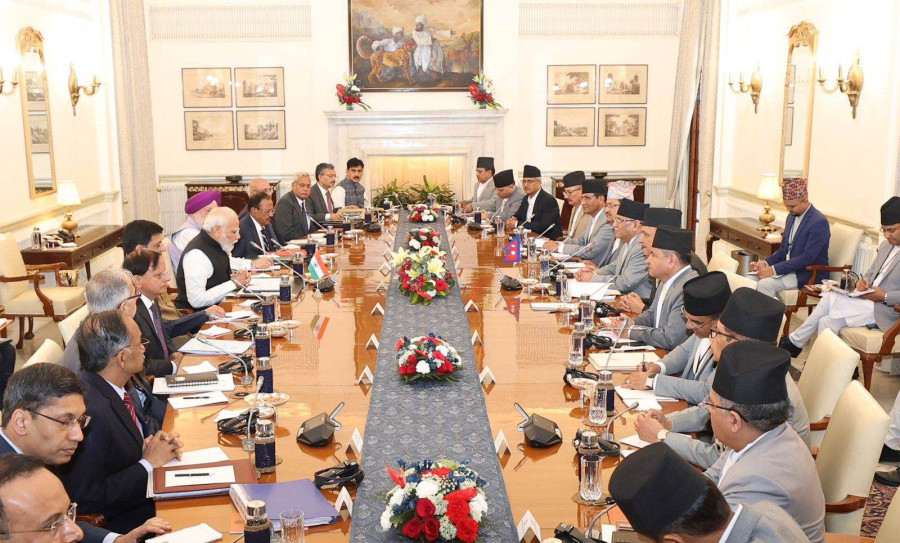National
India Cabinet okays plan to buy Nepal’s 10,000 MW power
Decision follows on Modi’s announcement during Dahal’s India visit. Nepali officials seek to sign an agreement soon.
Prithvi Man Shrestha
India has formalised its announcement that it would buy 10,000 megawatts of electricity from Nepal over 10 years with the endorsement of a long-term inter-government power trade agreement, Nepali officials said on Tuesday.
The 25-year long-term agreement was initiated when Prime Minister Pushpa Kamal Dahal visited India from May 31 to June 3. India’s Prime Minister Narendra Modi had announced during a joint press meet with Dahal that the southern neighbour would buy 10,000 MW of electricity in 10 years from Nepal under the long-term power trade agreement. “Under this agreement, we have set a target of importing 10,000 MW electricity from Nepal in the coming 10 years,” Modi said at the time.
On Tuesday, Nepal’s Ambassador to India Shankar Sharma announced on the social network X, previously known as Twitter, that India’s Cabinet had approved the agreement to purchase 10,000 MW of electricity from Nepal in the next 10 years. The decision, according to him, has paved the way for developing a new road map for electricity development in Nepal. “This could play a significant role in the development and economic restructuring of Nepal,” Sharma added.
The agreement could not officially be signed during Dahal’s Delhi visit. Nepali officials, however, expected the signing of the agreement immediately after the state visit, but it got delayed as the Indian Cabinet took time to endorse it.
Energy Secretary Dinesh Ghimire confirmed the Indian Cabinet’s decision.
“We will soon invite the Indian side to Nepal to sign the agreement which would officially make it a bilateral agreement,” he told the Post.
A few days ago, the Indian side had informally communicated the Indian Cabinet’s decision to Nepali officials. Nepali officials said there is also a provision for the renewal of the agreement. “After 25 years, it will be renewed every 10 years automatically,” Kul Man Ghising, managing director of the Nepal Electricity Authority (NEA), recently told the Post. “It can be amended with both sides agreeing.”
The Nepali officials said India has promised to import 10,000 MW of electricity from Nepal in 10 years under the medium- and long-term purchase agreements signed by the entities of the two countries.
Nepali officials and other stakeholders said that signing of the agreement would be important in the long-term as that would create an environment for more investments in Nepal’s power sector and export of power to the Indian market.
“It gives assurance of a market to investors who want to fund large projects in Nepal,” said Madhu Bhetuwal, spokesman at the energy ministry.
He said that the agreement would particularly promote investments from Nepal and India. Nepali stakeholders have also raised questions whether India would buy power generated by projects with investments from third countries.
But an official said the agreement does not state that India would not buy power generated by projects built with investments from third countries.
“As per the initial agreement, it has been stated that it will encourage mutually beneficial investments in the transmission and generation of hydropower. Some people are interpreting this provision to be that the southern neighbour will only buy power from projects with Indian investments,” said an official of the state-owned utility Nepal Electricity Authority. “The agreement does not say India will avoid buying power generated by projects with investments from other countries. India’s interest might be to promote increased investments from India.”
India’s SJVN Limited, which is developing the 900 MW Arun-3 Hydropower Project, has also been granted licence to develop the 669 MW Lower Arun Hydropower Project and the 490 MW Arun-4.
Arun-4 will be developed as a joint venture by the NEA and SJVN, which will have a majority stake.
Likewise, India’s NHPC Limited is also set to develop the 750 MW West Seti and the 450 MW Seti River-6 project. Similarly, the NHPC Limited and Vidyut Utpadan Company Limited signed a memorandum of understanding to jointly develop the 480 MW Phukot Karnali Project during Dahal’s India visit. Indian firm GMR is also making efforts to develop the 900 MW Upper Karnali Hydropower Project.
Ganesh Karki, president of the Independent Power Producers’ Association of Nepal, said Nepali and foreign investors would be interested to invest in Nepal’s hydropower sector once the long-term agreement is signed between the two countries. “This will also attract more Indian private sector investments in Nepal’s hydropower sector,” he said.
But Nepal’s power can go to India only by following the procedure for Approval and Facilitating Import/Export (Cross Border) of Electricity by the Designed Authority, which has detailed the process of how India would trade in electricity with its neighbours.
The procedure, introduced by the Central Electricity Authority of India in February 2021, bars the import of power from projects having direct or indirect control of China and Pakistan.
“If India wants to boost investor confidence, it should not delay the approval process,” Karki said.




 13°C Kathmandu
13°C Kathmandu










%20(1).jpg&w=300&height=200)




